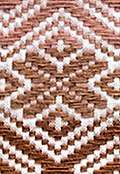Taffeta
Taffeta (/ˈtæfɪtə/; archaically spelled taffety) is a crisp, smooth, plain woven fabric made from silk or cuprammonium rayons as well as acetate and polyester. The word is Persian (تافته) in origin and means "twisted woven". It is considered to be a "high-end" fabric, suitable for use in ball gowns, wedding dresses, and in interior decoration for curtains or wallcoverings. It is also widely used in the manufacture of corsets and corsetry: it yields a more starched-like type of cloth that holds its shape better than many other fabrics. An extremely thin, crisp type of taffeta is called paper taffeta.[1][2]
.jpg)
There are two distinct types of silk taffeta: yarn-dyed and piece-dyed. Piece-dyed taffeta is often used in linings and is quite soft. Yarn-dyed taffeta is much stiffer and is often used in evening dresses. Shot silk taffeta was one of the most highly sought forms of Byzantine silk, and may have been the fabric known as purpura.[3]
Production
Modern taffeta was first woven in Italy and France and until the 1950s in Japan. Warp-printed taffeta or chiné, mainly made in France from the eighteenth century onwards, is sometimes called "pompadour taffeta" after Madame de Pompadour.[4] Today most raw silk taffeta is produced in India and Pakistan. There, even in the modern period, handlooms were long widely used, but since the 1990s it has been produced on mechanical looms in the Bangalore area. From the 1970s until the 1990s, the Jiangsu province of China produced fine silk taffetas: these were less flexible than those from Indian mills, however, which continue to dominate production. Other countries in Southeast Asia and the Middle East also produce silk taffeta, but these products are not yet equal in quality or competitiveness to those from India. The most deluxe taffetas, however, are still woven in France, Italy, Russia, and the United Kingdom.
Historical and current uses
Taffeta has seen use for purposes other than clothing fabric, including the following:
- On November 4, 1782, taffeta was used by Joseph Montgolfier of France to construct a small, cube-shaped balloon. This was the beginning of many experiments using taffeta balloons by the Montgolfier brothers, and led to the first known human flight in a lighter-than-air craft.
- Synthetic fibre forms of taffeta have been used to simulate the structure of blood vessels.[5]
- Tabby cats were so-named in the 1600s due to visual resemblance to a tabby, a type of striped silk taffeta.[6]
- It was associated with prostitution during the English Renaissance.[7] Examples include the references in William Shakespeare's plays: "As fit as ten groats is for the hand of an attorney, as your French crown for your taffeta punk," says the Clown in All's Well That Ends Well, Prince Hal's reference to Sir John Falstaff's "fair hot wench in flame-coloured taffeta" in Henry IV, Part 1, Boyet's dismissal of "Beauties no richer than rich taffeta" in Love's Labour's Lost, and Feste's insult in Twelfth Night, or What You Will, "The tailor make thy doublet of changeable taffeta, for thy mind is a very opal."
References
https://garmentmerchendising.com/what-is-a-taffeta-fabric/
- Shaeffer, Claire (2008). Claire Shaeffer's fabric sewing guide (2nd ed.). Cincinnati, Ohio: Krause Publications. p. 246. ISBN 9781440223426.
- Stevenson, Angus, ed. (2010). Oxford dictionary of English (3rd ed.). New York, NY: Oxford University Press. p. 1286. ISBN 9780199571123.
- Dodwell, C.R.; Anglo-Saxon Art, A New Perspective, pp. 145-150, 1982, Manchester UP, ISBN 0-7190-0926-X (US edn. Cornell, 1985)
- Fukai, Akiko (2002). Fashion : the collection of the Kyoto Costume Institute : a history from the 18th to the 20th century. Köln [etc.]: Taschen. p. 56. ISBN 9783822812068.
- "Heat sealed dacron taffeta blood vessel replacement". Surg Gynecol Obstet. 105 (3): 370–4. September 1957. PMID 13467673.
- "Entry for tabby". Online Etymology Dictionary. Douglas Harper. Retrieved 31 July 2018.
- David Scott Kastan (ed.). William Shakespeare. King Henry IV, Part 1. Arden Shakespeare Third Series. London: Thompson Learning, 2002, 150.
- Dictionary of Textiles, Louis Harmuth. New York: Fairchild Publishing Company, 1915, p. 184 (reprinted by Kessinger Publishing, 2010, ISBN 978-1-161-77823-6)
- Google Books edition of "Dictionary of Textiles"



.svg.png)